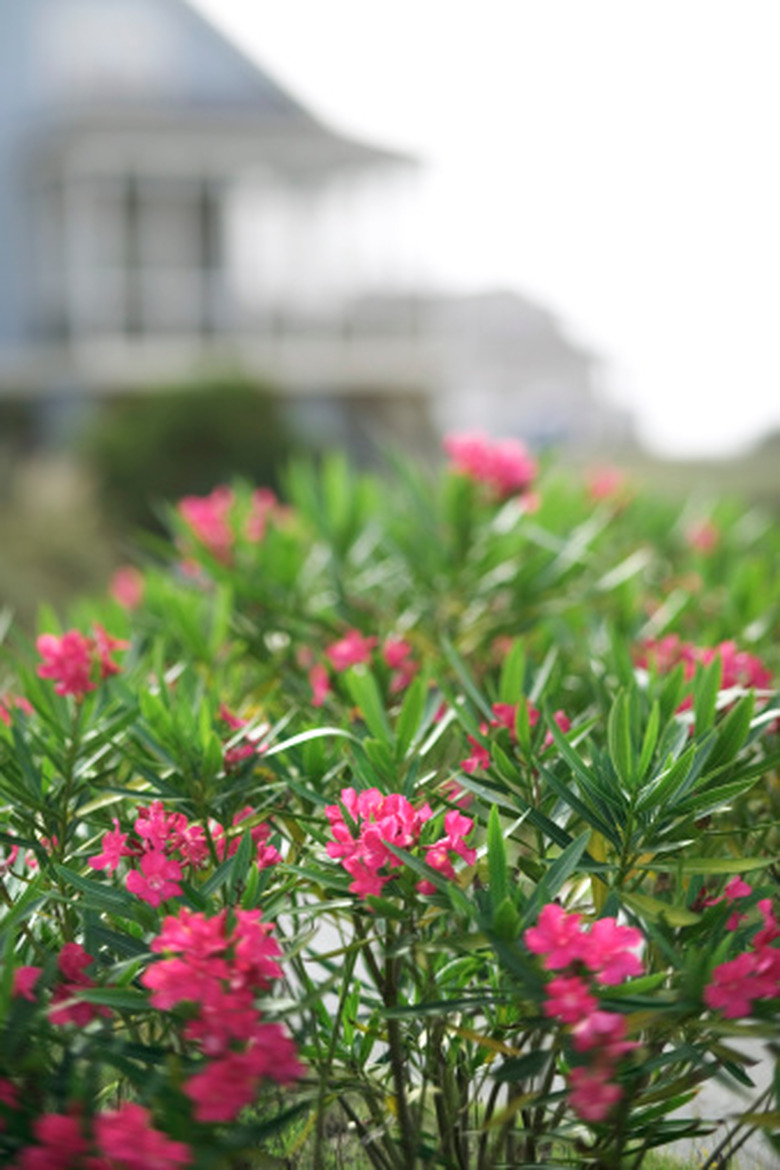The Growth Rate Of Oleander Plants
A rapidly growing shrub, the evergreen oleander (Nerium oleander) grows 1 to 2 feet per year, according to Clemson University Cooperative Extension. It will reach a height of up to 20 feet and attain a width of around 10 feet, if left to grow naturally.
A rapidly growing shrub, the evergreen oleander (Nerium oleander) grows 1 to 2 feet per year, according to Clemson University Cooperative Extension. It will reach a height of up to 20 feet and attain a width of around 10 feet, if left to grow naturally.
Temperature Effects
An oleander killed by a frost or a hard freeze will regrow rapidly from its root system once the old, dead growth is cut away. Damage usually occurs if the temperature dips below 20 degrees Fahrenheit, according to Texas A&M University AgriLife Extension.
Considerations
Oleanders flower only on new growth. Pruning the shrub in the fall months encourages it to reproduce new stems and bloom profusely. The oleander will flower year round. It produces clusters of blossoms in shades of pink, lavender, salmon, apricot, red, purple, pink and white. Each flower measures approximately 2 inches in width.
- A rapidly growing shrub, the evergreen oleander (Nerium oleander) grows 1 to 2 feet per year, according to Clemson University Cooperative Extension.
- Pruning the shrub in the fall months encourages it to reproduce new stems and bloom profusely.
Planting Location
Full sunlight encourages the oleander to produce a dense canopy. The shrub will grow in partial or even full shade, but its growth will be seriously stunted and leggy, according to Texas A&M University AgriLife Extension.
Growth Rate Of Oleander Plants
An oleander is generally suitable for U.S. Department of Agriculture plant hardiness zones 8 through 10 and is a medium- to fast-growing plant under proper conditions. An oleander grows best in a spot that gets bright sun for most of the day, although it can tolerate partial shade for a few hours each day. In areas with hot, intense summer sun, the best location is one that gets full sun until early afternoon and then gets light, filtered shade during the hottest afternoon hours. Although the oleander is tolerant of drought, stress from extended dry spells can slow its growth rate. Feeding is best done in early spring, when new growth first appears, and again in early fall, to help the plant store nutrients for the next season. Generally, you should add 2 pounds each of nitrogen, phosphorus and potassium per 1,000 square feet of ground occupied by oleander roots, which usually extend about 2 feet beyond the plant's drip line.
- Full sunlight encourages the oleander to produce a dense canopy.
- An oleander grows best in a spot that gets bright sun for most of the day, although it can tolerate partial shade for a few hours each day.
References
- Clemson University Cooperative Extension: Oleander
- University of Oklahoma Department of Biology and Microbiology: Nerium Oleander
- University of Arizona Pima County Cooperative Extension: Nerium Oleander
- Clemson Cooperative Extension: Oleander
- Floridata: Nerium Oleander
- AgriLife Extension: Oleanders (Nerium Oleander)
- International Oleander Society: Oleander Culture
- North Carolina Department of Agriculture and Consumer Services: A Homeowner's Guide to Fertilizer
